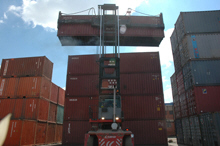REGIONAL ECONOMIC OUTLOOK

Typical street scene in Santa Ana, El Salvador. (Photo: iStock)
IMF Survey: Africa’s Private Capital Inflows Resilient in Crisis
April 23, 2010
- Capital flows boom-bust cycle less marked in Africa than in other regions
- Recent private capital surge bypassed many of region’s poorest countries
- Policies to liberate productive potential can also help attract private inflows
External financing flows to sub-Saharan Africa during the global crisis proved to be less of a constraint than feared.

Container depot in Johannesburg, South Africa: terms of trade movements topped impact of reversal in private capital flows for many countries (IMF photo)
The IMF’s Regional Economic Outlook for sub-Saharan Africa noted that the boom-bust cycle in private financial inflows was less marked than in other regions, largely due to the high share of foreign direct investment over other more volatile forms of private capital. Remittances also fell only slightly and official financing flows have increased in response to efforts by the IMF and other agencies to scale up support in response to the crisis.
More than one-third of countries in the region, however, remain on the margins of international capital markets and dependent on official forms of external financing. Though the report found some encouraging signs that access to private capital had broadened during the expansion, two-thirds of inflows over the last economic cycle went to the two biggest economies, South Africa and Nigeria, while eight countries had negative inflows and another 10 shared just 1 percent of the regional total between them.
Source of volatility
For the region as a whole, financial flows have typically been a greater source of volatility than trade flows when measured over a full economic cycle, the report said. During the current crisis, however, movements in the terms of trade outweighed the impact of the reversal in private capital flows for many countries. For oil producers, a massive deterioration in their terms of trade, equivalent to 27 percent of GDP in 2009, was exacerbated by the reduced availability of private external financing. For non-oil producers, however, terms of trade gains in 2008–09 largely offset the financing shock.
With multilateral institutions scaling up support, an increase in official financing partially compensated for the reduction in private capital inflows during the crisis and the share of official flows in total financing to the region rose sharply. Bilateral donors also need to further increase their support if they are to meet preexisting aid commitments. While the recent dramatic weakening of public finances and the expectation that economic recoveries will be anemic in donor countries make this more challenging, these commitments are small relative to total donor budgets.
Attracting, accommodating private inflows
Among countries that attracted significant capital inflows before the crisis, there is some evidence that better macroeconomic management when funds were flowing in also produced superior performance when the global financial crisis hit and private capital flows diminished.
Specifically, countries that had shown more fiscal restraint when inflows were surging experienced less deterioration in economic growth after the crisis. By contrast, the intensity of resistance to upward pressure on exchange rates during the inflow period and the level of restrictiveness in capital account regimes do not seem to have made a difference in the slowdown resulting from the crisis.
From a longer-term perspective, especially given the budget woes of traditional donors, competition for external private financing is likely to become more intense. Experience within sub-Saharan Africa suggests that the same sorts of reforms needed to liberate productive potential—promoting trade and financial sector development, encouraging domestic savings and investment, raising standards of governance, and building up institutions—are also likely to help attract sustained private inflows.







